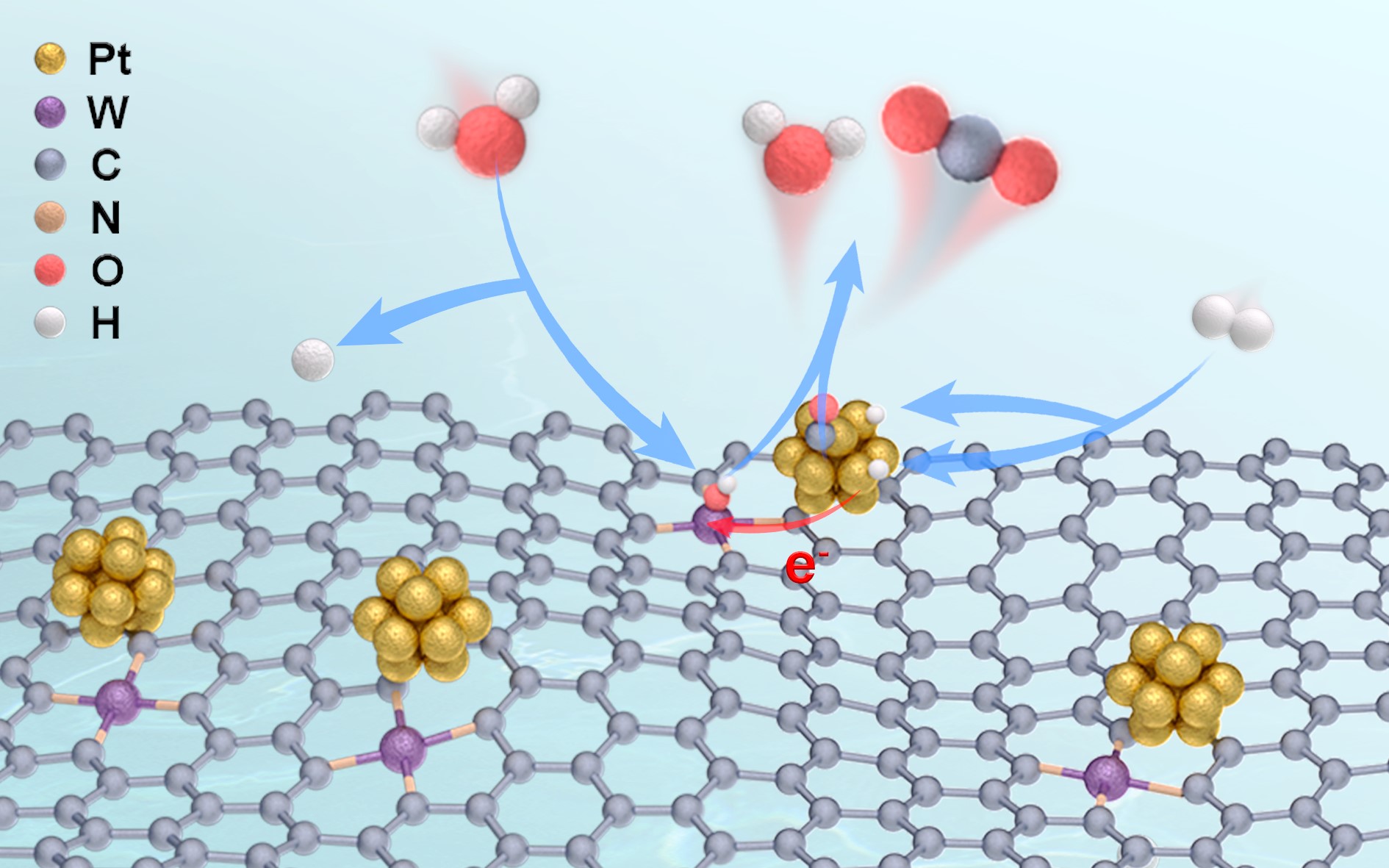Atomically Dispersed Tungsten for Enhanced Platinum-based Catalysts in Proton Exchange Membrane Fuel Cells
Published 20 May, 2025
The development and optimization of proton exchange membrane fuel cells (PEMFCs) represent a significant stride toward sustainable energy systems, especially as the world shifts away from fossil fuel dependency. One of the core reactions in PEMFCs is the anodic hydrogen oxidation reaction (HOR), for which platinum (Pt)-based catalysts are widely used due to their excellent catalytic activity. However, a major challenge practical applications is the sensitivity of Pt to carbon monoxide (CO) poisoning.
Pt has a moderate adsorption capacity for hydrogen, which allows for the efficient adsorption and rapid release of H2 to efficiently promote HOR. The CO adsorption on Pt surfaces generally involves a two-step electron transfer mechanism, where the 5σ orbitals of the CO molecule interact with the d-orbitals on the metal surface, followed by back-donation of electrons from the metal d-orbitals into the 2π* orbitals of the CO molecule. This back-donation strengthens CO adsorption and inhibits HOR. To address this, introducing transition metals can shift the d-band center of Pt, reducing electron back-donation to CO to decrease the adsorption strength. This adjustment helps optimize both the hydrogen binding energy (HBE) and CO tolerance.
Among transition metals, tungsten (W) has shown promise due to its unique d-orbital coupling ability. W can effectively adjust the electronic structure of Pt, with its superior oxygen affinity promoting CO dissociation and oxidation on the catalyst surface, thereby enhancing CO tolerance and catalytic stability. Conventionally, W has been used in compound form, which limits its active site exposure. In contrast, atomically dispersed W sites maximize surface availability and atomic utilization efficiency.
Building on these insights, a team of researchers in Harbin, China, successfully synthesized a novel Pt/W@NCNF composite catalyst consisting of Pt nanoparticles and atomical dispersed W sites on N-doped carbon nanofibers. Notably, the electron transfer from Pt to W modifies the 5d-orbitals electronic structure of Pt, reducing hydrogen intermediate adsorption and enhancing HOR activity. Further, the atomical dispersed W oxophilic sites provide OH* intermediates that are crucial for the timely oxidation and removal of CO* adsorbed on Pt.
As a result, Pt/W@NCNF offers outstanding HOR exchange current density and mass activity — 1.4 and 20.6 times higher, respectively, than that of state-of-the-art Pt/C. Notably, the limiting current density of Pt/W@NCNF declines by only 3.4% even in an H2 environment containing 1000 ppm CO, indicating exceptional CO tolerance. When employed as an anode catalyst in PEMFC, Pt/W@NCNF achieves a peak power density of 1.27 W cm−2 and a high mass activity of 16.9 W mgₚₜ−1.
The new fundings, published in Advanced Powder Materials, demonstrate that electronic modulation of Pt is an effective strategy for simultaneously achieving resistance to CO and promoted HOR activity.

Contact author details: Lei Wang (wanglei0525@hlju.edu.cn).
Key Laboratory of Functional Inorganic Materials Chemistry, Ministry of Education of the People’s Republic of China, Heilongjiang University, Harbin, 150080, China.
Funder: This work was supported by the National Natural Science Foundation of China (22179034, 22279030), the Natural Science Foundation of Heilongjiang Province (ZD2023B002). The authors also thank Prof. Fanfei Sun from Shanghai Synchrotron Radiation Facility, Shanghai Advanced Research Institute, Chinese Academy of Science for measurements of XAFS spectroscopy.
Conflict of interest: The authors declare that they have no known competing financial interests or personal relationships that could have appeared to influence the work reported in this paper.
See the article: by Lei Wang, et al. Atomically Dispersed Tungsten Enhances CO Tolerance in Electrocatalytic Hydrogen Oxidation by Regulating the 5d-Orbital Electrons of Platinum. Advanced Powder Materials, Volume 4, Issue 3, 2025, 100288. https://doi.org/10.1016/j.apmate.2025.100288